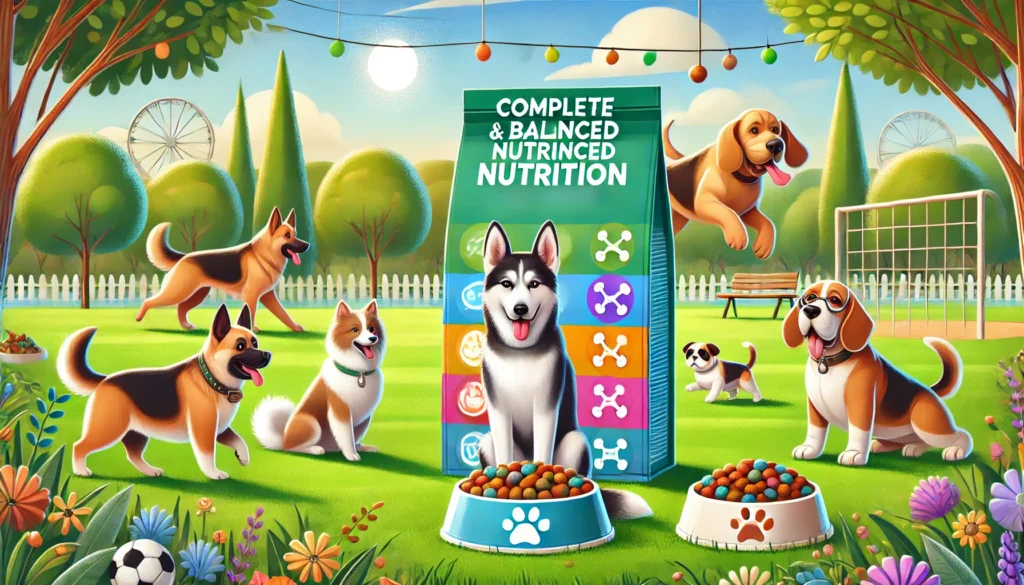Table of Contents
How to Choose Dog Food Based on Breed
Introduction
Choosing the right food for your dog isn’t just a routine decision—it’s a vital part of ensuring their health, happiness, and longevity. Different breeds come with unique nutritional needs shaped by their size, activity level, and predisposition to specific health issues. For instance, what works for a sprightly Border Collie may not suit a laid-back Bulldog.
This blog will walk you through how to select the best dog food for your furry friend by understanding their breed-specific requirements, decoding ingredient labels, and making informed decisions with the help of your veterinarian. Let’s dive into the world of canine nutrition and discover how to keep your pup thriving.
Understanding Breed-Specific Nutritional Needs
No two dogs are the same, and their dietary needs are as diverse as their breeds. Factors like size, energy levels, and genetic predispositions play a significant role in determining what they should eat. Here’s a breakdown of how these elements influence nutrition:
Large Breeds: Growing Strong Without Overloading
Large breeds, such as Golden Retrievers and Great Danes, require diets that support their rapid growth and prevent health complications. These dogs are prone to joint issues like hip dysplasia, so controlling their calorie and calcium intake is essential. Look for foods designed to maintain a healthy weight and contain glucosamine or chondroitin for joint support.
Small Breeds: Packing Energy Into Every Bite
Small breeds, like Chihuahuas and Pomeranians, have high metabolic rates and need calorie-dense food to fuel their energetic lifestyles. Their smaller stomachs mean they benefit from frequent, smaller meals packed with essential nutrients. Opt for kibble specifically sized for smaller jaws to make eating easier.

Active vs. Less Active Breeds: Balancing Energy Needs
- Active Breeds: Dogs like Border Collies or Siberian Huskies have boundless energy and require high-calorie diets rich in protein to sustain their active lifestyles. Look for food with quality protein sources like chicken or salmon, and ensure it has the right balance of fats for stamina.
- Less Active Breeds: Breeds like Bulldogs or Basset Hounds are more prone to weight gain. They thrive on a controlled-calorie diet with lower fat content and higher fiber to keep them feeling full without unnecessary weight gain.
Section 2: Decoding Dog Food Labels
When choosing dog food, the packaging can often feel like a minefield of jargon and marketing buzzwords. Deciphering these labels is key to ensuring you’re selecting high-quality nutrition for your dog. For instance, the U.S. Food and Drug Administration (FDA) has investigated potential links between certain diets and canine dilated cardiomyopathy (DCM), particularly concerning grain-free diets.
Here’s how to navigate them like a pro:
Ingredient Lists: Prioritize Quality Over Quantity
- Order of Ingredients: Ingredients are listed by weight, meaning the first item is the primary component. Look for high-quality proteins like “chicken,” “beef,” or “lamb” as the first ingredient, rather than fillers like corn or by-products.
- Named Protein Sources: Specificity is important—choose foods with named meats (e.g., “salmon” or “chicken”) instead of vague terms like “poultry” or “meat meal.”
- Whole Grains vs. By-Products: Whole grains, such as brown rice or oatmeal, are better options than grain by-products, which provide less nutritional value.
- Avoid Artificial Additives: Steer clear of foods with artificial colors, flavors, or preservatives. These can be harmful to your dog over time.
Understanding Nutritional Claims
- “Complete and Balanced”: This phrase means the food meets the minimum nutritional standards set by the Association of American Feed Control Officials (AAFCO). Always look for this statement to ensure your dog is getting the essential nutrients.
- “Natural” or “Organic”: These terms can vary in definition. For “organic,” look for USDA certifications, and for “natural,” check for clear labeling of ingredients without synthetic additives.
- “Grain-Free”: Grain-free doesn’t automatically mean healthier. Some dogs thrive on grain-inclusive diets, and grain-free foods have been linked to heart conditions in certain breeds. Always consult your vet before switching to a grain-free option.

Guaranteed Analysis: A Nutritional Snapshot
The guaranteed analysis lists the minimum percentages of crude protein and fat, and the maximum percentages of fiber and moisture. Here’s how to interpret these values:
- Crude Protein: A higher protein percentage is generally better, especially for active breeds.
- Crude Fat: Provides energy, but ensure it’s balanced for your dog’s activity level.
- Crude Fiber: Helps with digestion—ideal for less active breeds prone to weight gain.
By breaking down these details, you can confidently pick a food that aligns with your dog’s specific needs.
Section 3: Identifying High-Quality Dog Food
Not all dog foods are created equal. High-quality options stand out for their ability to provide complete nutrition while avoiding harmful additives. Here are the hallmarks of premium dog food:
Quality Markers to Look For
- AAFCO Statement of Nutritional Adequacy: Foods with this certification meet the necessary nutritional requirements for dogs at different life stages.
- Specific Meat Sources: High-quality dog foods list named meat as the primary ingredient. Avoid those where meat by-products or fillers dominate.
- No Artificial Preservatives, Colors, or Flavors: Choose foods that use natural preservatives like tocopherols (Vitamin E) or ascorbic acid (Vitamin C) instead of synthetic chemicals.
- Appropriate Fat-to-Protein Ratio: Different breeds have unique fat and protein needs. For example, active breeds need higher protein, while less active breeds benefit from lower fat content.
Understanding Breed-Specific Needs
- Large breeds often require controlled calcium and calorie levels to avoid overgrowth.
- Small breeds need calorie-dense food to meet their high energy demands.
- Senior dogs benefit from formulas with added joint support like glucosamine and chondroitin.
Scientific Backing Matters
A study published in the Journal of Nutritional Science highlighted significant variations in dietary needs across breeds. Breed-specific formulas cater to these differences, but the overall quality of the ingredients and nutritional profile is paramount.
Section 4: Practical Tips for Pet Owners
Even after narrowing down your options, selecting the best dog food and ensuring your dog transitions smoothly can feel overwhelming. Here are practical tips to make the process easier and more effective:
Consult Your Veterinarian
- Breed-Specific Guidance: Your vet knows your dog’s unique requirements and can recommend foods tailored to their size, breed, and health conditions.
- Address Special Needs: If your dog has allergies, a sensitive stomach, or specific medical issues, a vet-recommended diet can make all the difference.
Factor in Age, Activity Level, and Health
- Age: Puppies, adults, and senior dogs have distinct dietary needs. Puppy food is calorie-dense for growth, while senior dog food often includes joint and digestion support.
- Activity Level: Active dogs require more calories and protein to fuel their energy, while less active breeds benefit from lower-fat, controlled-calorie diets.
- Health Status: Dogs with chronic conditions like kidney disease or obesity may need specialized therapeutic diets.
Transition Gradually
- Avoid Digestive Upsets: Sudden diet changes can cause upset stomachs. Gradually mix the new food with the old over 7–10 days, increasing the proportion of new food daily.
- Monitor for Reactions: Look out for signs of allergies or intolerance, such as itching, vomiting, or diarrhea.
Monitor Your Dog’s Response
- Energy Levels: A well-nourished dog is typically energetic and playful.
- Coat and Skin: Shiny, smooth fur and healthy skin are signs of good nutrition.
- Stool Quality: Consistent, firm stools indicate that the food is digestible and well-balanced.
Be Cautious with Grain-Free Diets
- Grain-free diets have become popular, but they’re not always better. Some have been linked to heart conditions in certain breeds. Always consult your vet before switching to grain-free options.
By following these tips, you’ll not only choose the best food for your dog but also ensure a seamless transition and long-term health benefits.
Section 5: Conclusion
Choosing the right dog food based on breed doesn’t have to be a daunting task. Armed with the right knowledge, you can make informed decisions that prioritize your dog’s health and happiness.
Key Takeaways
- Understand Breed-Specific Needs: Tailor your dog’s diet to their size, activity level, and health predispositions.
- Decode Labels: Focus on ingredient quality, nutritional claims, and guaranteed analysis to choose the best option.
- Identify Quality: Look for AAFCO certifications, named proteins, and a balanced fat-to-protein ratio.
- Consult Experts: Your veterinarian can provide invaluable guidance.
- Monitor and Adapt: Pay attention to your dog’s response and make adjustments as needed.
Remember, while breed-specific formulas can provide tailored nutrition, the ultimate goal is to select a high-quality dog food that meets your pet’s individual needs. With proper research, professional advice, and careful observation, you can give your furry friend the nutrition they need to thrive.
Call to Action
Your dog’s health starts with their diet! Consult your veterinarian today, and take the first step towards ensuring a lifetime of wellness for your loyal companion. Share your experiences or questions in the comments below—we’d love to hear from you!
FAQs: How to Choose Dog Food Based on Breed
1. What is breed-specific dog food, and is it necessary?
Breed-specific dog food is formulated to address the unique dietary needs of certain breeds. For instance, large breeds like Labradors may benefit from joint-supporting nutrients, while smaller breeds like Chihuahuas need calorie-dense food. While these formulas can be helpful, high-quality, balanced nutrition tailored to your dog’s individual needs is the most important factor.
2. How do I know if my dog is getting the right nutrients?
Look for signs of good health, including:
- Shiny, smooth coat
- High energy levels
- Consistent, firm stools
- Healthy skin If you’re unsure, consult your veterinarian for advice on assessing your dog’s diet and overall health.
3. Are grain-free diets better for all dogs?
Not necessarily. Grain-free diets are sometimes recommended for dogs with grain allergies, but they are not inherently superior for all dogs. In fact, grain-free diets have been linked to heart conditions (dilated cardiomyopathy) in some breeds. Always consult your vet before switching to grain-free food.
4. What should I do if my dog doesn’t like their breed-specific food?
If your dog refuses to eat their breed-specific formula:
- Gradually transition to the new food by mixing it with their old food over a week.
- Ensure the food’s texture and flavor match your dog’s preferences (e.g., wet vs. dry food).
- If they still refuse it, consult your vet to explore alternative options that meet their nutritional needs.
5. How often should I change my dog’s food?
Change your dog’s food only when necessary, such as when transitioning between life stages (puppy to adult, adult to senior) or addressing specific health needs. Sudden or frequent changes can upset your dog’s digestive system, so always transition gradually over 7–10 days.
6. How do I choose the best food for my dog with allergies?
If your dog has food allergies:
- Identify common allergens (e.g., chicken, beef, wheat) by consulting your vet.
- Opt for hypoallergenic or limited-ingredient diets that exclude the triggering ingredients.
- Monitor your dog’s response and consult your vet for tailored advice.
7. What is AAFCO, and why is it important?
The Association of American Feed Control Officials (AAFCO) sets nutritional standards for pet foods. A food labeled as “complete and balanced” under AAFCO guidelines ensures it meets the minimum nutritional requirements for your dog’s life stage. Always look for the AAFCO statement on dog food packaging.
8. How do I interpret the guaranteed analysis on dog food?
The guaranteed analysis provides the percentages of crude protein, fat, fiber, and moisture in the food. For example:
- Crude Protein: Essential for muscle and energy.
- Crude Fat: Provides energy and supports coat health.
- Crude Fiber: Aids digestion. Use these values to compare different brands and align with your dog’s specific needs.
9. Can I feed my dog human food instead of commercial dog food?
While some human foods (e.g., plain cooked chicken, carrots) are safe as occasional treats, they should not replace balanced dog food. Human diets lack essential nutrients like taurine and specific vitamins that dogs need. Always consult your vet before making homemade dog food.
10. How can I tell if a food is high-quality?
High-quality dog food has:
- AAFCO certification for nutritional adequacy
- Named protein sources as the primary ingredient (e.g., “chicken” or “salmon”)
- No artificial preservatives, colors, or flavors
- A balanced fat-to-protein ratio suited for your dog’s breed and life stage Reading labels and consulting your vet can help ensure you’re making the best choice.




